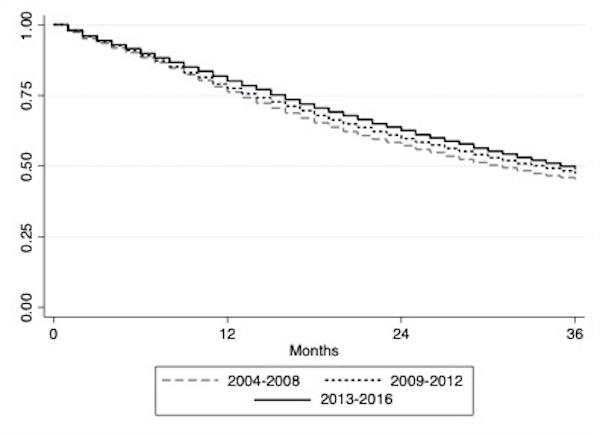Back
Poster, Podium & Video Sessions
Podium
PD13: Prostate Cancer: Epidemiology & Natural History II
PD13-09: Trends in Survival for Men with De Novo Metastatic Prostate Cancer
Friday, May 13, 2022
4:50 PM – 5:00 PM
Location: Room 252
Nina Wyatt*, Christopher Filson, Atlanta, GA
- NW
Podium Presenter(s)
Introduction: The USPSTF recommended against routine prostate cancer screening in 2008 (men > 75 years) and 2011 (all men). After 2010, novel therapies were approved for men with metastatic prostate cancer, such as abiraterone. We examined the characteristics and survival of the men presenting with metastatic prostate cancer before and after those time periods. We hypothesized that men diagnosed more recently would have improved survival compared to men diagnosed long ago.
Methods: Using SEER cancer registry data, we identified men newly diagnosed with metastatic prostate cancer diagnosis from 2004–2018. Our outcome of interest was prostate cancer specific survival. Primary exposure was time period of diagnosis (2004–2008; 2009–2012; 2013–2016; 2017–2018). We evaluated factors including age, race/ethnicity, registry, and PSA level. We performed survival analysis to generate Kaplan-Meier curves for men eligible for at least 3 years follow up (diagnosed 2004–2016) (Figure). Multivariable Cox proportional hazard model provided adjusted estimates for cancer specific survival.
Results: Among 840,852 prostate cancer patients, 47,343 (5.6%) had metastatic disease. This proportion increased from 4.2% in 2004–2008 to 8.1% in 2017– 2018 (p
Conclusions: Men presenting with metastatic prostate cancer in more recent years are living longer. More work will need to evaluate the relative contribution to this finding from therapeutic successes with novel systemic therapies, stage migration with adoption of PET scans, and the impact of earlier cancer detection with screening
Source of Funding: ACS MRSG 18-1-CPHPS

Methods: Using SEER cancer registry data, we identified men newly diagnosed with metastatic prostate cancer diagnosis from 2004–2018. Our outcome of interest was prostate cancer specific survival. Primary exposure was time period of diagnosis (2004–2008; 2009–2012; 2013–2016; 2017–2018). We evaluated factors including age, race/ethnicity, registry, and PSA level. We performed survival analysis to generate Kaplan-Meier curves for men eligible for at least 3 years follow up (diagnosed 2004–2016) (Figure). Multivariable Cox proportional hazard model provided adjusted estimates for cancer specific survival.
Results: Among 840,852 prostate cancer patients, 47,343 (5.6%) had metastatic disease. This proportion increased from 4.2% in 2004–2008 to 8.1% in 2017– 2018 (p
Conclusions: Men presenting with metastatic prostate cancer in more recent years are living longer. More work will need to evaluate the relative contribution to this finding from therapeutic successes with novel systemic therapies, stage migration with adoption of PET scans, and the impact of earlier cancer detection with screening
Source of Funding: ACS MRSG 18-1-CPHPS


.jpg)
.jpg)